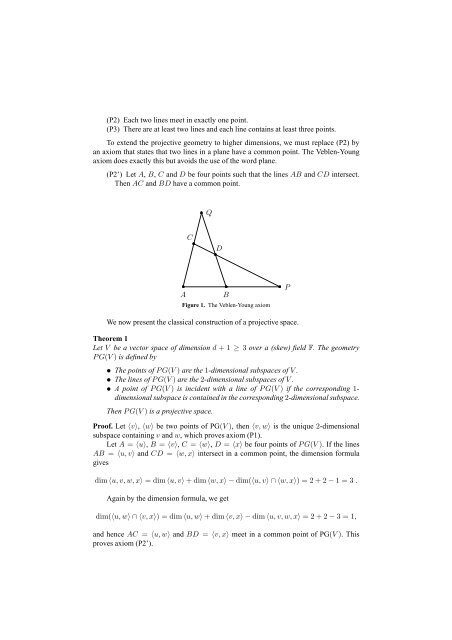Applications of finite geometry in coding theory and cryptography
Applications of finite geometry in coding theory and cryptography
Applications of finite geometry in coding theory and cryptography
You also want an ePaper? Increase the reach of your titles
YUMPU automatically turns print PDFs into web optimized ePapers that Google loves.
¥¤(P2) Each two l<strong>in</strong>es meet <strong>in</strong> exactly one po<strong>in</strong>t.(P3) There are at least two l<strong>in</strong>es <strong>and</strong> each l<strong>in</strong>e conta<strong>in</strong>s at least three po<strong>in</strong>ts.To extend the projective <strong>geometry</strong> to higher dimensions, we must replace (P2) byan axiom that states that two l<strong>in</strong>es <strong>in</strong> a plane have a common po<strong>in</strong>t. The Veblen-Youngaxiom does exactly this but avoids the use <strong>of</strong> the word plane.(P2’) Let A, B, C <strong>and</strong> D be four po<strong>in</strong>ts such that the l<strong>in</strong>es AB <strong>and</strong> CD <strong>in</strong>tersect.Then AC <strong>and</strong> BD have a common po<strong>in</strong>t.QC£¢DA¡BFigure 1. The Veblen-Young axiomPWe now present the classical construction <strong>of</strong> a projective space.Theorem 1Let V be a vector space <strong>of</strong> dimension d + 1 ≥ 3 over a (skew) field F. The <strong>geometry</strong>PG(V ) is def<strong>in</strong>ed by• The po<strong>in</strong>ts <strong>of</strong> PG(V ) are the 1-dimensional subspaces <strong>of</strong> V .• The l<strong>in</strong>es <strong>of</strong> PG(V ) are the 2-dimensional subspaces <strong>of</strong> V .• A po<strong>in</strong>t <strong>of</strong> PG(V ) is <strong>in</strong>cident with a l<strong>in</strong>e <strong>of</strong> PG(V ) if the correspond<strong>in</strong>g 1-dimensional subspace is conta<strong>in</strong>ed <strong>in</strong> the correspond<strong>in</strong>g 2-dimensional subspace.Then PG(V ) is a projective space.Pro<strong>of</strong>. Let 〈v〉, 〈w〉 be two po<strong>in</strong>ts <strong>of</strong> PG(V ), then 〈v, w〉 is the unique 2-dimensionalsubspace conta<strong>in</strong><strong>in</strong>g v <strong>and</strong> w, which proves axiom (P1).Let A = 〈u〉, B = 〈v〉, C = 〈w〉, D = 〈x〉 be four po<strong>in</strong>ts <strong>of</strong> PG(V ). If the l<strong>in</strong>esAB = 〈u, v〉 <strong>and</strong> CD = 〈w, x〉 <strong>in</strong>tersect <strong>in</strong> a common po<strong>in</strong>t, the dimension formulagivesdim 〈u, v, w, x〉 = dim 〈u, v〉 + dim 〈w, x〉 − dim(〈u, v〉 ∩ 〈w, x〉) = 2 + 2 − 1 = 3 .Aga<strong>in</strong> by the dimension formula, we getdim(〈u, w〉 ∩ 〈v, x〉) = dim 〈u, w〉 + dim 〈v, x〉 − dim 〈u, v, w, x〉 = 2 + 2 − 3 = 1,<strong>and</strong> hence AC = 〈u, w〉 <strong>and</strong> BD = 〈v, x〉 meet <strong>in</strong> a common po<strong>in</strong>t <strong>of</strong> PG(V ). Thisproves axiom (P2’).
















